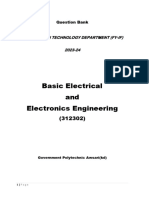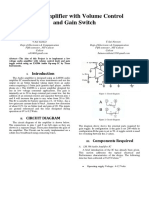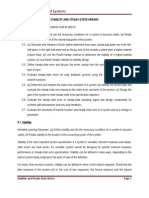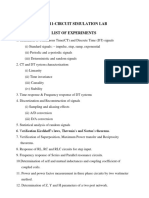Lecture#4 State Space Model
Uploaded by
Alfares KingLecture#4 State Space Model
Uploaded by
Alfares KingProf.
Wahied GHARIEB
EE455: Applied Control
Lecture# 4
State Space Model
2 EE455: Applied Control
Advantages of State Space Approach
Classical Approach
Modern Control Approach
Transfer Function
Linear Time Invariant
System, SISO
Laplace Transform,
Frequency domain
Only Input-output
Description: Less Detail
Description on System
Dynamics
State Variable Approach
Linear Time Varying,
Nonlinear, Time
Invariant, MIMO
Time domain
Detailed description of
Internal behavior in
addition to I-O
properties
3 EE455: Applied Control
State Space Representation
Select a particular subset of all possible independent
system variables and call them state variables.
For an nth-order system, write n simultaneous first-
order differential equations in terms of state
variables.
If we know the initial conditions of all state variables
at t
0
and the system input for t>t
0
, we can solve the
simultaneous differential equations for the state
variables for t>t
0
.
4 EE455: Applied Control
Concept of State Variable
System variable: Any variable that responds to an input or initial
conditions in a system.
State variables: The smallest set of linearly independent system
Variables.
Sate vector: A vector whose elements are the state variables.
State space: The n-dimensional space whose axes are the state variables.
State equations: A set of n simultaneous, first-order differential equations
with n variables, where the n variables to be solved are the state variables.
Output equation: The algebraic equation that expresses the output
variables of a system as linear combinations of the state variables and the
inputs.
5 EE455: Applied Control
Dynamic System must involve elements that memorize
the values of the input
Integrators in CT serve as memory devices
Outputs of integrators are considered as internal state
variables of the dynamic system
Number of state variables to completely define the
dynamics of the system=number of integrators involved
Concept of State Variable
6 EE455: Applied Control
State Space Model
Input equation
Output equation
7 EE455: Applied Control
State Space Model
Most linear systems encountered are time-invariant: A, B,
C, D are constant, i.e., dont depend on t
Example: DC motor with constant coefficients
when u(t) and y(t) are scalar, system is called single-
input, single-output (SISO)
when input & output signal dimensions are vectors,
MIMO
Example: Aircraft , Electrical power station
8 EE455: Applied Control
Mass-Spring-damper system
Therefore, we define variable x
1
and
x
2
.
) ( ) (
) ( ) (
2
2
t r t ky
dt
t dy
b
dt
t y d
M = + +
y x =
1
y x
=
2
Dynamic equation of the
system:
9 EE455: Applied Control
If the measured output of the system
is position, then we have:
In matrix form:
General State-Space
Model:
Mass-Spring-damper system
10 EE455: Applied Control
Electrical System
11 EE455: Applied Control
RLC Circuit
12 EE455: Applied Control
RLC Circuit
13 EE455: Applied Control
RLC Circuit
Example: Given the electric network, find a state-space
representation. (Hint: state variables V
c
and i
L
, output i
R
)
) (
/ 1
0
0 / 1
/ 1 ) /( 1
t v
L i
v
L
C RC
i
v
L
C
L
C
(
+
(
=
(
| |
(
=
L
C
R
i
v
R i 0 / 1
14 EE455: Applied Control
Block Diagram of State Space model
Time Invariant System
A(t)= State Matrix
B(t)= Input Matrix
C(t)=Output Matrix
D(t)=Direct Transmission Matrix
15 EE455: Applied Control
c x
c x
c x
=
=
=
3
2
1
1
3 2 1 3
3 2
2 1
24 9 26 24
x y
r x x x x
x x
x x
=
+ =
=
=
Transfer Function to State Space
16 EE455: Applied Control
Decomposed Transfer Function
17 EE455: Applied Control
Decomposed Transfer Function
18 EE455: Applied Control
State Space to Transfer Function
Du Cx y
Bu Ax x
+ =
+ =
Given the state and output equations
Take the Laplace transform assuming zero initial conditions:
(1)
(2)
Solving for in Eq. (1),
or
(3)
Substituting Eq. (3) into Eq. (2) yields
The transfer function is
) ( ) ( ) (
) ( ) ( ) (
s s s
s s s s
DU CX Y
BU AX X
+ =
+ =
) (s X
) ( ) ( ) ( s s s BU X A I =
) ( ) ( ) (
1
s s s BU A I X
=
) ( ) ( ) ( ) (
1
s s s s DU BU A I C Y + =
) ( ] ) ( [
1
s s U D B A I C + =
D B A I C
U
Y
+ =
1
) (
) (
) (
s
s
s
19 EE455: Applied Control
Eigen Values
Roots of Characteristics
Equation
Example
20 EE455: Applied Control
Diagonalization of nxn matrix
21 EE455: Applied Control
Diagonalization of nxn matrix
22 EE455: Applied Control
Diagonalization of nxn matrix
23 EE455: Applied Control
Diagonalization of nxn matrix
24 EE455: Applied Control
Diagonalization of nxn matrix
Another approach using the eigenvectors:
For distinct eigenvalues solve the equation
Where i is the eigenvalues index
i i i
P P A =
] P ...... P [P matrix n nsformatio linear tra The
n 2 1
=
25 EE455: Applied Control
Invariance of Eigenvalues
26 EE455: Applied Control
Free Response of State Space Model
) ( ) ( t Ax t x
dt
d
=
By taking Laplace transform
) 0 ( ) ( ) 0 ( ) ( ) (
) ( ) 0 ( ) (
1
x s x A sI s x
s Ax x s x s
u = =
=
) ( ) (
) 0 ( ) ( ) (
nxn matrix transition state t
x t t x
u
u =
By taking inverse Laplace transform
27 EE455: Applied Control
Free Response of State Space Model
(t) compute ,
4 - 3 -
1 0
u
(
= A
1
) ( ) (
= u A sI s
1
4 - 3 -
1 0
s 0
0
) (
(
|
|
.
|
\
|
|
|
.
|
\
|
= u
s
s
1
4 s 3
1 -
) (
(
|
|
.
|
\
|
+
= u
s
s
28 EE455: Applied Control
Free Response of State Space Model
(
|
|
.
|
\
|
+
+ +
= u
s 3 -
1 4
3 ) 4 (
1
) (
s
s s
s
(
u u
u u
=
(s) ) (
(s) ) (
22 21
12 11
s
s
3
5 . 0
1
5 . 1
) 1 )( 3 (
4
) (
11
+
+
=
+ +
+
= u
s s s s
s
s
3
5 . 0
1
5 . 0
) 1 )( 3 (
1
) (
12
+
+
=
+ +
= u
s s s s
s
29 EE455: Applied Control
Free Response of State Space Model
3
5 . 1
1
5 . 1
) 1 )( 3 (
3
) (
21
+
+
+
=
+ +
= u
s s s s
s
3
5 . 1
1
5 . 0
) 1 )( 3 (
) (
22
+
+
+
=
+ +
= u
s s s s
s
s
(
(
+ +
= u
) e 1.5 5 . 0 ( ) e 1.5 5 . 1 (
) e 0.5 - 5 . 0 ( ) e 0.5 - 5 . 1 (
) (
3t - 3t -
-3t -3t
t t
t t
e e
e e
t
) 0 ( ) ( ) ( x t t x u =
30 EE455: Applied Control
Forced Response of state space model
) ( ) ( ) ( t Bu t Ax t x
dt
d
+ =
By taking Laplace transform
) ( ) ( ) 0 ( ) ( ) (
) ( ) ( ) 0 ( ) ( ) (
) ( ) ( ) 0 ( ) (
1 1
s Bu s x s s x
s Bu A sI x A sI s x
s Bu s Ax x s x s
u + u =
+ =
+ =
}
}
u + u =
u + u =
t
t
d Bu t x t t x
d t Bu x t t x
0
0
) ( ) ( ) 0 ( ) ( ) (
) ( ) ( ) 0 ( ) ( ) (
t t t
t t t
By taking inverse
Laplace transform
31 EE455: Applied Control
Forced Response of state space model
(
=
(
=
(
=
1
0
(0) x
(0) x
,
1
0
B ,
4 - 3 -
1 0
2
1
A
Free response
t t
t t
e e t x
e e t x
3
2
3
1
5 . 1 5 . 0 ) (
5 . 0 5 . 0 ) (
+ =
=
Forced response
t
t
t t
t
t
t t
e d e e t x
e d e e t x
3
0
) ( 3 ) (
2
3
0
) ( 3 ) (
1
] 5 . 1 5 . 0 [ ) (
) 1 (
3
1
] 5 . 0 5 . 0 [ ) (
= + =
= =
}
}
t
t
t t
t t
Complete response = free response + forced response
You might also like
- Application of Digital Signal Processing in Radar: A StudyNo ratings yetApplication of Digital Signal Processing in Radar: A Study4 pages
- 45 - 70685 - EE411 - 2013 - 1 - 1 - 1 - Control System I-State SpaceNo ratings yet45 - 70685 - EE411 - 2013 - 1 - 1 - 1 - Control System I-State Space84 pages
- Topic 10 Nonlinear Systems and Their LinearizationsNo ratings yetTopic 10 Nonlinear Systems and Their Linearizations20 pages
- Hamilton, J.D. - Time Series Analysis PDFNo ratings yetHamilton, J.D. - Time Series Analysis PDF407 pages
- Lecture-11 Impulse Response & Convolution Integral in CT LTI SystemNo ratings yetLecture-11 Impulse Response & Convolution Integral in CT LTI System25 pages
- Power Plant Instrumentation: Lecture NotesNo ratings yetPower Plant Instrumentation: Lecture Notes35 pages
- Princom Fundamentals of Frequency ModulationNo ratings yetPrincom Fundamentals of Frequency Modulation5 pages
- Design of DC Motor Fuzzy-Pi Controller UNo ratings yetDesign of DC Motor Fuzzy-Pi Controller U5 pages
- Ei 7211-Circuit Simulation Lab List of ExperimentsNo ratings yetEi 7211-Circuit Simulation Lab List of Experiments61 pages
- Slideserve - Co.uk-Power Electronics and Power Systems PDFNo ratings yetSlideserve - Co.uk-Power Electronics and Power Systems PDF49 pages
- Antenna Azimuth Position Control System Verification100% (1)Antenna Azimuth Position Control System Verification4 pages
- Solutions To Chapter 11 Problems: Problem 11.1No ratings yetSolutions To Chapter 11 Problems: Problem 11.169 pages
- Chapter 6 - FET Biasing: Your Answer: Correct AnswerNo ratings yetChapter 6 - FET Biasing: Your Answer: Correct Answer6 pages
- Feedback and Control Systems: Activity No. 2 - Time Response of Dynamic SystemsNo ratings yetFeedback and Control Systems: Activity No. 2 - Time Response of Dynamic Systems15 pages
- Developing Counter and Time Delay RoutineNo ratings yetDeveloping Counter and Time Delay Routine24 pages
- Tutorial I Basics of State Variable ModelingNo ratings yetTutorial I Basics of State Variable Modeling11 pages
- Nonlinear Programming 3rd Edition Theoretical Solutions ManualNo ratings yetNonlinear Programming 3rd Edition Theoretical Solutions Manual20 pages
- Chapter 3 Controllability and Observability Part II PDFNo ratings yetChapter 3 Controllability and Observability Part II PDF37 pages
- Student Solutions Manual to Accompany Economic Dynamics in Discrete Time, secondeditionFrom EverandStudent Solutions Manual to Accompany Economic Dynamics in Discrete Time, secondedition4.5/5 (2)
- Nonlinear Control Feedback Linearization Sliding Mode ControlFrom EverandNonlinear Control Feedback Linearization Sliding Mode ControlNo ratings yet
- Introduction To Cognitive Robots: Prof. Brian WilliamsNo ratings yetIntroduction To Cognitive Robots: Prof. Brian Williams17 pages
- Time To Move On From Mean Time Between Failure (MTBF) and Mean Time To Failure (MTTF)No ratings yetTime To Move On From Mean Time Between Failure (MTBF) and Mean Time To Failure (MTTF)4 pages
- Mastering Machine Learning With Scikit-Learn: Chapter No. 5 "Nonlinear Classification and Regression With Decision Trees"No ratings yetMastering Machine Learning With Scikit-Learn: Chapter No. 5 "Nonlinear Classification and Regression With Decision Trees"23 pages
- Quantitative Analysis For Management III: Course Instructor: SoniaNo ratings yetQuantitative Analysis For Management III: Course Instructor: Sonia24 pages
- Dsa Assignment 1 (3) by Zamir Ali 091440No ratings yetDsa Assignment 1 (3) by Zamir Ali 09144044 pages
- A Comparison of Two Linear Algebra BooksNo ratings yetA Comparison of Two Linear Algebra Books3 pages
- Natural Response Neither Grows Nor Approaches Zero As Time (ForNo ratings yetNatural Response Neither Grows Nor Approaches Zero As Time (For9 pages
- 11 Solving Linear IVPs by Laplace TransformsNo ratings yet11 Solving Linear IVPs by Laplace Transforms14 pages
- Introduction To Simulation Grid Design and Upscaling MethodsNo ratings yetIntroduction To Simulation Grid Design and Upscaling Methods2 pages
- Big-M Method (Introduction) : Artificial VariableNo ratings yetBig-M Method (Introduction) : Artificial Variable10 pages
- Experiment: Digital Image Processing: Image As A 2 D SignalNo ratings yetExperiment: Digital Image Processing: Image As A 2 D Signal16 pages
- Unit 6: Stability of Linear Control SystemNo ratings yetUnit 6: Stability of Linear Control System14 pages
- Application of Digital Signal Processing in Radar: A StudyApplication of Digital Signal Processing in Radar: A Study
- 45 - 70685 - EE411 - 2013 - 1 - 1 - 1 - Control System I-State Space45 - 70685 - EE411 - 2013 - 1 - 1 - 1 - Control System I-State Space
- Topic 10 Nonlinear Systems and Their LinearizationsTopic 10 Nonlinear Systems and Their Linearizations
- Lecture-11 Impulse Response & Convolution Integral in CT LTI SystemLecture-11 Impulse Response & Convolution Integral in CT LTI System
- Ei 7211-Circuit Simulation Lab List of ExperimentsEi 7211-Circuit Simulation Lab List of Experiments
- Slideserve - Co.uk-Power Electronics and Power Systems PDFSlideserve - Co.uk-Power Electronics and Power Systems PDF
- Antenna Azimuth Position Control System VerificationAntenna Azimuth Position Control System Verification
- Chapter 6 - FET Biasing: Your Answer: Correct AnswerChapter 6 - FET Biasing: Your Answer: Correct Answer
- Feedback and Control Systems: Activity No. 2 - Time Response of Dynamic SystemsFeedback and Control Systems: Activity No. 2 - Time Response of Dynamic Systems
- Nonlinear Programming 3rd Edition Theoretical Solutions ManualNonlinear Programming 3rd Edition Theoretical Solutions Manual
- Chapter 3 Controllability and Observability Part II PDFChapter 3 Controllability and Observability Part II PDF
- Student Solutions Manual to Accompany Economic Dynamics in Discrete Time, secondeditionFrom EverandStudent Solutions Manual to Accompany Economic Dynamics in Discrete Time, secondedition
- Nonlinear Control Feedback Linearization Sliding Mode ControlFrom EverandNonlinear Control Feedback Linearization Sliding Mode Control
- Introduction To Cognitive Robots: Prof. Brian WilliamsIntroduction To Cognitive Robots: Prof. Brian Williams
- Time To Move On From Mean Time Between Failure (MTBF) and Mean Time To Failure (MTTF)Time To Move On From Mean Time Between Failure (MTBF) and Mean Time To Failure (MTTF)
- Mastering Machine Learning With Scikit-Learn: Chapter No. 5 "Nonlinear Classification and Regression With Decision Trees"Mastering Machine Learning With Scikit-Learn: Chapter No. 5 "Nonlinear Classification and Regression With Decision Trees"
- Quantitative Analysis For Management III: Course Instructor: SoniaQuantitative Analysis For Management III: Course Instructor: Sonia
- Natural Response Neither Grows Nor Approaches Zero As Time (ForNatural Response Neither Grows Nor Approaches Zero As Time (For
- Introduction To Simulation Grid Design and Upscaling MethodsIntroduction To Simulation Grid Design and Upscaling Methods
- Experiment: Digital Image Processing: Image As A 2 D SignalExperiment: Digital Image Processing: Image As A 2 D Signal

























































































